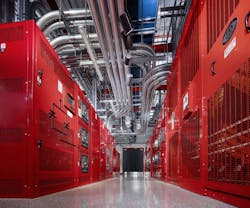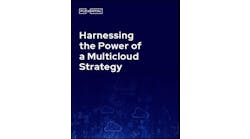The data center is an ever-changing entity and part of our technological landscape. But sometimes the biggest changes in the colocation industry happen at the core of what makes a data center tick, and may not be visible at first glance. In this instance, we’re talking about data center power, and the potential of creative solutions on the market, such as using Gallium nitride (GaN) in power conversion equipment.
Download the latest Data Center Frontier Special Report on GaN computing.
The common belief among data center leaders is that the industry’s current power conversion technology is good enough. But that’s simply not the case anymore, as we look to a future of expansive data growth and demands for data center space.
Gartner estimates that ongoing power costs are increasing at least 10 percent per year due to cost per kilowatt-hour (kwh) increases and underlying demand, especially for high power density servers. A recent NRDC report indicates that data center electricity consumption is projected to increase to roughly 140 billion kwh annually by 2020 — the equivalent annual output of 50 power plants — costing American businesses $13 billion annually in electricity bills.
Meanwhile, the latest AFCOM State of the Data Center report found that the majority of respondents report rack power density is increasing. And although rack power density is increasing, that same report also indicates very little growth around actual enterprise data center capacity requirements.
This means that today’s data center leaders are tasked with doing more, but with less space. Let’s also take into account that power currently comprises approximately 10 percent of data center operating expenses (OPEX), and that number is expected to rise by 15 percent within five years.
On top of growing power needs, the data center landscape is changing due to the newly trending edge computing designs. Edge computing will directly impact the way smaller data center locations are deployed, from rack density to power consumption. The goal of edge data centers and edge computing is to place facilities close to where data is being created and consumed, creating more data centers that must be smaller and hyper-efficient. For edge designs, data center managers will benefit from advanced power solutions delivering higher performance, higher power efficiency and greater power density.
How Will Data Center Power Systems Keep up?
The market currently has its eye on Gallium nitride (GaN) to use in power conversion equipment. Although GaN has been around for a while, it’s relatively new to the data center scene.
It is now being researched for its potential to bring greater efficiency to data center power distribution as an alternative to traditional silicon-based transistors.
Transistors first gained widespread use because they were small, flexible and efficient. And over the course of the 1970s and 1980s, transistor enhancements such as more integrated circuits, and earlier iterations of compute technologies, made the technology even more popular. The silicon-based metal-oxide-semiconductor field-effect transistor (MOSFET) was at the center of it all.
In today’s market, we’re capping out on silicon-driven power efficiency. But it’s not all bad news. Better data center solutions are materializing. For the first time in decades, emerging semiconductor technologies are proving to be more efficient than silicon while reducing overall power system costs.
Enter GaN. The wide bandgap semiconductor material hit the market in the 1990s, and perhaps its most well-known use is a key component in LED lighting technology. But there are many additional uses, and today, it’s also being used in the production of semiconductor power devices and RF radio components.
For the first time in decades, emerging semiconductor technologies are proving to be more efficient than silicon while reducing overall power system costs.
The first enhancement-mode gallium nitride transistors became generally available in 2010. And when it comes to data center and power efficiency, GaN may just act as an alternative to MOSFETs.
GaN has the potential to be a disruptive technology. When compared to silicon, GaN can increase power density by as much as 40 percent, switches two to three times faster, reduces heat dissipation and can cut down on overall power system cost.
Ultimately, use of rack mount power supplies and other equipment built using high-voltage GaN have the potential to produce the power density required to maximize rack space and, ultimately, a data center’s overall performance.
A reference design for a Transphorm AC to DC Power System using gallium nitride (GaN) technology. (Image: Transphorm USA)
GaN Technology Gaining Interest
Though introduced in recent years, high-voltage GaN is in production and accessible. What’s more, reputable power supply and industrial equipment manufacturers are in production — including Bel Power, CORSAIR, Seasonic, Yaskawa — selling GaN-based products that demonstrate GaN’s ability to increase efficiency and power density
Over a year ago, Transphorm, which focuses on high-performance, high-reliability GaN products, announced that Bel Power introduced the first-ever AC-DC power supply using Transphorm GaN FETs. Other vendors in this market include GAN Systems and Efficient Power Conversion, which each offer products for data center operators, as well.
As for cost, consider this. Leaders in the power space have been researching and developing high-voltage GaN for a decade or more. As such, many GaN platforms and products are already third-generation tech. Research and generational improvements have not only increased performance, quality and reliability, but they have also enabled transistor price reductions year over year. This shows us that high-voltage GaN innovation and volume increases will drive down cost. And many are already using GaN to decrease overall data center OPEX costs. See direct examples in our latest Data Center Frontier special report on GaN technology.
The market will also likely begin to see more product manufacturers releasing servers, power supplies and other end equipment leveraging GaN’s semiconductor technology’s benefits.
For now, GaN is still a relatively new technology, but adoption is growing. The reality is demand for power density, cost and space will continue to grow, and those challenges certainly aren’t going anywhere. The industry will have to continue looking for answers to these crucial questions, and GaN very well could be part of the answer.
For the latest and most in-depth coverage of GaN technology and how it relates to the data center industry and future data center power, see below for Data Center Frontier’s latest coverage, including articles and a special report series.
Explore the evolving world of edge computing further through Data Center Frontier’s special report series and ongoing coverage.






